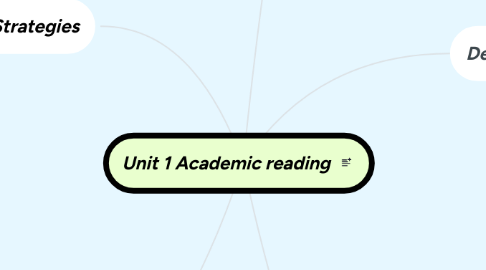
1. Collocation of vocabulary
1.1. Collocation is 2 or more words that go together and fit perfectly with a real meaning.
1.2. Collocations with common verbs: Do-Make- Get- Give
1.3. Based on any part of speech
1.3.1. Adjective- noun collocations
1.3.2. Adverb- adjective collocations
1.3.3. Noun- noun collocations
1.4. The best way to find and learn collocations
1.4.1. To do regular reading and listening practice
1.5. Try to notice the collocations you see or her
1.6. How to remember and use collocations
1.6.1. Learn vocabulary from real life sources
1.6.2. Learn and review vocabulary in full sentences.
1.6.3. System to review vocabulary regularly
1.6.4. Need to use it
2. Reading Strategies
2.1. Opinion - proof
2.1.1. Demonstrate
2.1.1.1. Supporting information
2.1.1.1.1. Trustworthy
2.2. Venn Diagram
2.2.1. Comparisons
2.2.1.1. Overlapping circles
2.2.1.1.1. Organize information
2.3. Summarizing
2.3.1. Develop brief expressions
2.3.1.1. Make larger ideas shorter
2.3.1.1.1. Focused on key words
2.4. Power Thinking
2.4.1. Outlining information: Main ideas, Subtopics, Details
2.4.1.1. Grouped by levels
2.5. Selective Underlining
2.5.1. Highlighting: Key words, Phrases, Ideas, Particular ends
2.5.1.1. Successful performance, Strategic, Purposeful
2.6. Reciprocal Teaching
2.6.1. To promote comprehension by tackling the ideas in a text on several fronts
2.6.1.1. A compilation of four comprehension strategies: summarizing, questioning, clarifying, predicting
2.7. Without effective reading strategies, many students struggle and a large percentage will be left behind when they are unable to acquire the skills necessary to read grade-level materials.
3. Dennotations and connotations
3.1. Describing the meanings of words.
3.1.1. CONNOTATION
3.1.1.1. Positive and Negative associations that the majority of the words.
3.1.1.2. Emotional and imaginative association.
3.1.2. EXAMPLE
3.1.2.1. _3_ thin _4_ bony _1_ slim _5_ anorexic _2_ slender
3.1.2.1.1. Thin (general denotation)
3.1.2.1.2. The connotation is from positive 1 to negative 5.
3.1.3. DENOTATION
3.1.3.1. The precise and literal definition of a word.
3.1.3.2. The strict dictionary meaning.
4. Use of dictionaries
4.1. Develop and increase their vocabulary
4.1.1. Activities
4.1.1.1. Word walls
4.1.1.2. Personal vocabulary book
4.1.1.3. Exit card
4.1.1.4. Entry cards
4.1.1.5. Tic-Tac-Toe
4.1.1.6. Memo Test
4.1.1.7. Crossword puzzles
4.2. Valuable resource
4.2.1. PPP
4.2.1.1. Developing their skills step by step
4.2.2. TBL
4.2.2.1. students analyze the structures
4.2.3. ESA
4.2.3.1. flexible for different tasks
4.3. Learn new words
4.3.1. Activating schema
4.3.1.1. introduce the theme and students thinking about what they already know
4.3.2. Vocabulary In Context
4.3.2.1. give clear definitions through context, pictures, and examples
4.3.3. Building Collocations
4.3.3.1. words work together
4.3.3.2. students are strengthening their knowledge
4.3.3.3. repetition and memorization
4.4. Take risks to learn
4.4.1. Development of the comprehension of the new word
4.5. Different levels of students
4.5.1. Beginner
4.5.1.1. Pictures and examples
4.5.2. Intermediate
4.5.2.1. Simple word definitions and clear examples
4.5.3. Advanced
4.5.3.1. Complete definitions
5. Active reading and thinking skills
5.1. Tips for English Reading comprehension tests
5.2. Take note all unkown words.
5.3. Answer all questions.
5.4. Check the questions and find the mistakes.
5.5. Reading techniques
5.6. Scanning
5.6.1. Find a particular piece of information
5.7. Skimming
5.7.1. Gather the most important information as quickly as possible
5.8. Intensive Reading
5.8.1. Find the details of a specific information
5.9. Extensive Reading
5.9.1. Find general information of a passagefind general information of a passage
